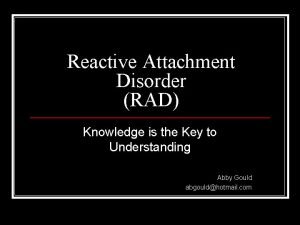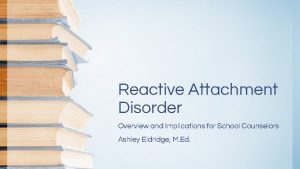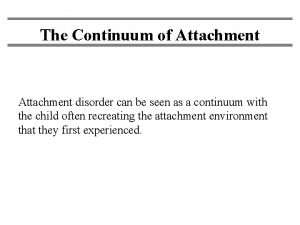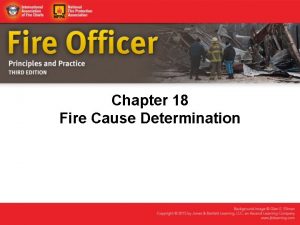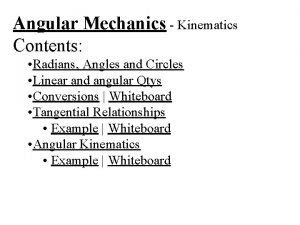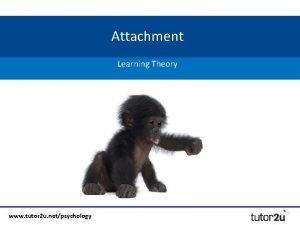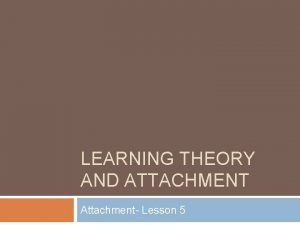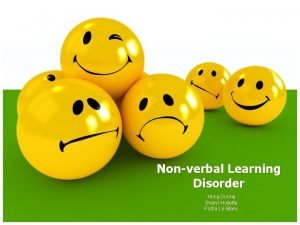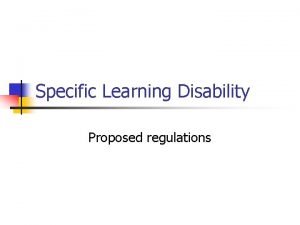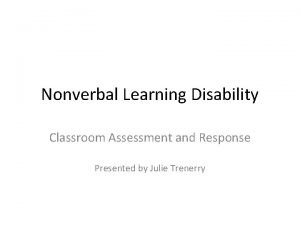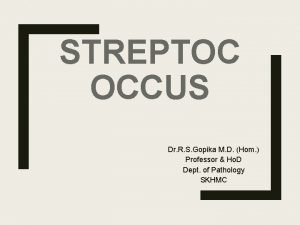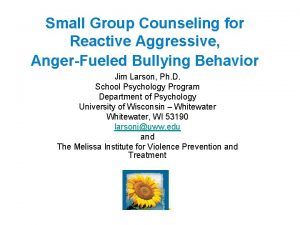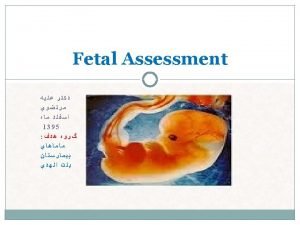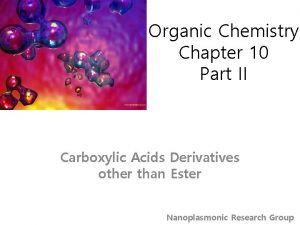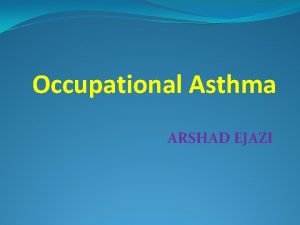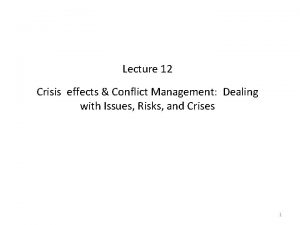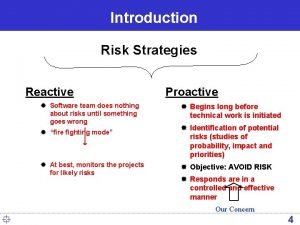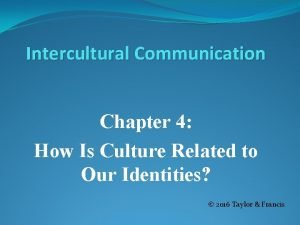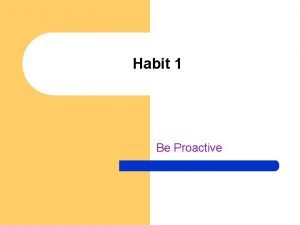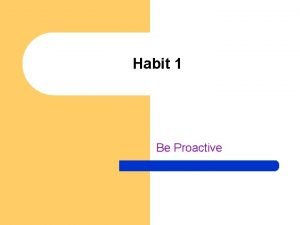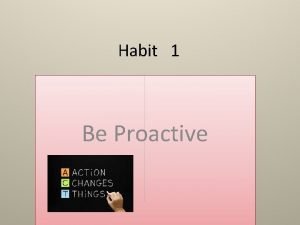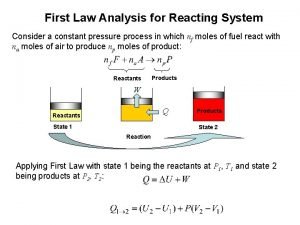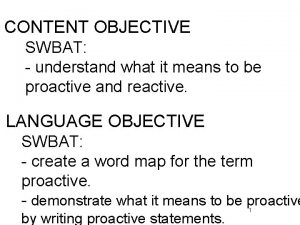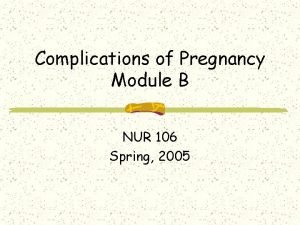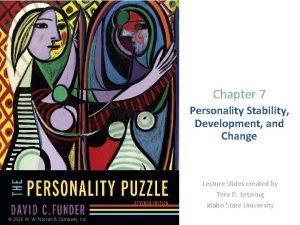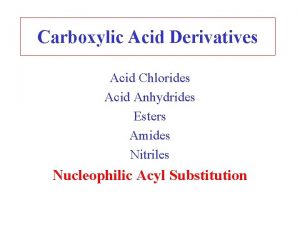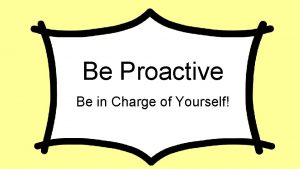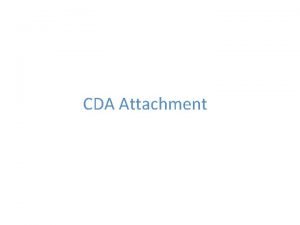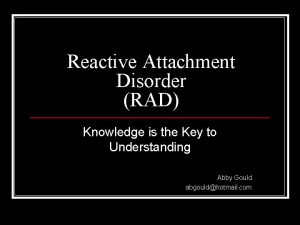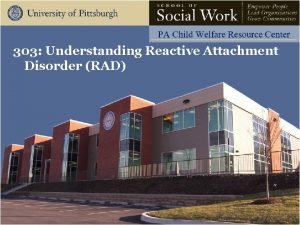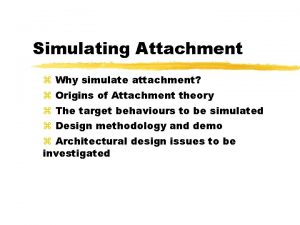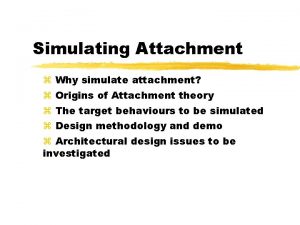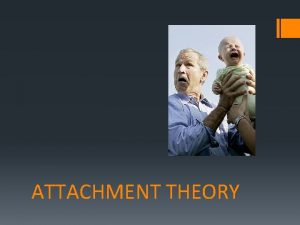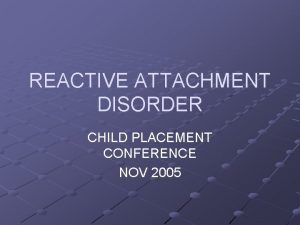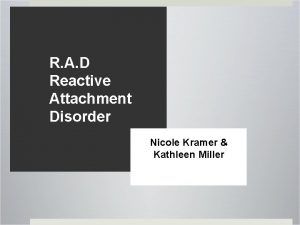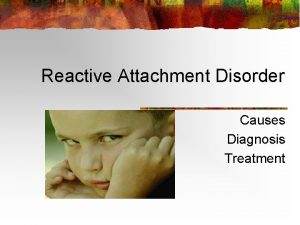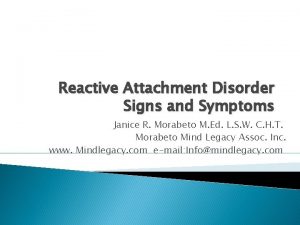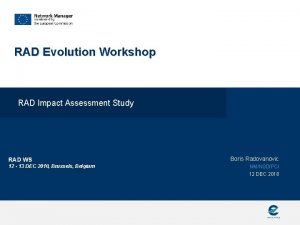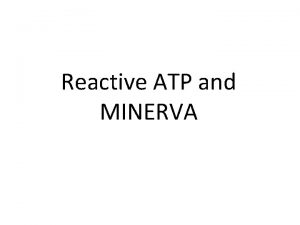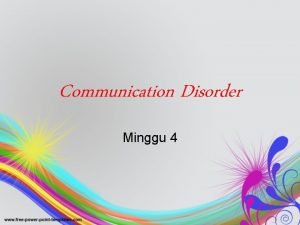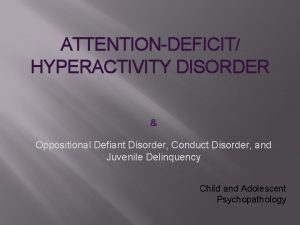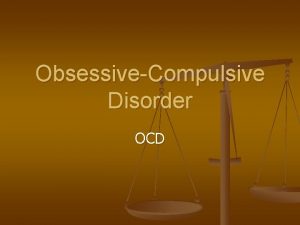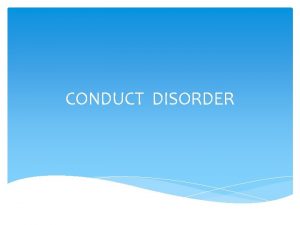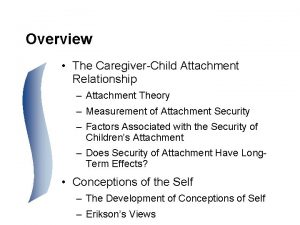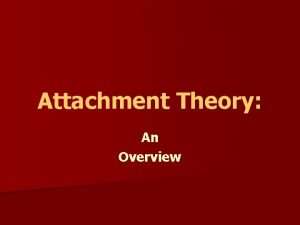921 Reactive Attachment Disorder RAD An Overview Learning








































- Slides: 40

921: Reactive Attachment Disorder (RAD): An Overview

Learning Objectives • Describe how healthy attachment occurs • Describe the effects of maltreatment and disordered attachment on brain development, self concept and behavior • Define risk factors for and symptoms of Reactive Attachment Disorder (RAD) and related disorders • List the recommended approaches for diagnosis and treatment of RAD and related disorders • Utilize attachment parenting principles when caring for a child with RAD The Pennsylvania Child Welfare Resource Center 921: Reactive Attachment Disorder: An Overview 2

Agenda I. III. IV. Introduction Development of healthy attachment Effects of unhealthy attachment Symptoms, diagnosis and treatment of RAD and related disorders V. Parenting principles that promote attachment VI. Closing The Pennsylvania Child Welfare Resource Center 921: Reactive Attachment Disorder: An Overview 3

Healthy Attachment The Pennsylvania Child Welfare Resource Center 921: Reactive Attachment Disorder: An Overview 4

Poll Think about your response to separating from the person(s) you are MOST attached to for 6 months. What would you want? A. To feel secure, I would not need any contact. B. To feel secure, I would want monthly contact. C. To feel secure, I would want weekly contact. D. To feel secure, I would want daily contact. E. To feel secure, I would tell them don’t go! The Pennsylvania Child Welfare Resource Center 921: Reactive Attachment Disorder: An Overview 5

How Does Healthy Attachment Occur? • Watch the First Years Last Forever clip • Can you identify the five main things parents are doing in the clip that facilitate parent/child attachment? The Pennsylvania Child Welfare Resource Center 921: Reactive Attachment Disorder: An Overview 6

Normal Cycle of Attachment • Infant feels need (hunger, pain, attention) • Infant is aroused and expresses need (cry) • Response/gratification (need is promptly met in nurturing way) • Relief/relaxation (infant feels relief and relaxes, develops TRUST) The Pennsylvania Child Welfare Resource Center 921: Reactive Attachment Disorder: An Overview 7

Normal Cycle of Attachment Need Relief Relaxation Arousal Expression Response Gratification The Pennsylvania Child Welfare Resource Center 921: Reactive Attachment Disorder: An Overview 8

Disordered Cycle of Attachment • • Infant feels need (hunger, pain, attention) Infant is aroused and expresses need (cry) There is no response, or response is angry/punitive There is not relief/relaxation (infant develops anger/rage and learns not to depend on caregivers for need satisfaction) The Pennsylvania Child Welfare Resource Center 921: Reactive Attachment Disorder: An Overview 9

Disordered Cycle of Attachment Need Discomfort/Fear/ Arousal Anxiety Expression Lack of Trust in Apathy Others & Lack of Empathy No Response -> Anger The Pennsylvania Child Welfare Resource Center 921: Reactive Attachment Disorder: An Overview 10

Continuum of Attachment SECURE ANXIOUS DISORGANIZED NONATTACHED Comfortable with closeness and trust Felt security Vulnerability acceptable Positive working model Individuality, togetherness balanced Resists or ambivalent about closeness or trust Moderately controlling and insecure Negative working model Rejecting or clingy Unable to trust or be close Lacks remorse Aggressive and punitive control Negative working model (severe) Pseudoindependent Unable to form emotional connections Lacks conscience Predatory behaviors Negative working model (severe) Extreme narcissism (From: Attachment, Trauma, and Healing, p. 94) The Pennsylvania Child Welfare Resource Center 921: Reactive Attachment Disorder: An Overview 11

Effects of Unhealthy Attachment The Pennsylvania Child Welfare Resource Center 921: Reactive Attachment Disorder: An Overview 12

Effect on the Brain • Frontal Lobes – Manages impulse control, social reasoning, organization and planning • Amygdala – Assesses threats and danger in the environment and results in fight, flight or freeze responses (Source: Dr. Bruce D. Perry, 2006, The Boy Who was Raised as a Dog) The Pennsylvania Child Welfare Resource Center 921: Reactive Attachment Disorder: An Overview 13

Effect on the Brain: Hand Model Let’s watch Dr. Siegel’s hand model of the brain – http: //www. youtube. com/watch? v=DD-lf. P 1 FBFk 1) What does this mean for children who did not develop smooth regulation and impulse control as a result of disrupted attachment early in life? 2) What does this mean for us as parents when we respond to some of the extreme behaviors exhibited by children with disordered attachment? 3) How can you use this hand model with children who struggle with regulating their emotions, impulses and sensory responses? The Pennsylvania Child Welfare Resource Center 921: Reactive Attachment Disorder: An Overview 14

Beliefs: About Self and the World • People are untrustworthy and inconsistent • The world is chaotic, unpredictable and unsafe • Nothing I say or do has an impact, not on others, myself or situations • My needs will only be met through my own efforts: I have to do it all myself (Source: Cross, 2003, Dyadic Developmental Psychotherapy) The Pennsylvania Child Welfare Resource Center 921: Reactive Attachment Disorder: An Overview 15

Beliefs: About Self and the World (cont. ) • I am worthless, unlovable and bad • I am unsafe and weak • Caretakers are unresponsive, unreliable and dangerous • The world is hostile and dangerous. (Source: Cross, 2003, Dyadic Developmental Psychotherapy) The Pennsylvania Child Welfare Resource Center 921: Reactive Attachment Disorder: An Overview 16

Behavior: Attachment Disruption Signs INFANCY TODDLER Lack of eye contact Excessive tantrums SCHOOL AGE ADOLESCENCE Tantrums continue Drug/Alcohol abuse Cruel to animals Excessive sexual behaviors (multiple partners) Inability to soothe Self-Injury Does not express needs Overly friendly/ attentionseeking with strangers Slow development Affectionate on and weight gain their own terms The Pennsylvania Child Welfare Resource Center Encopresis/ Enuresis Lying, hoarding, stealing, destruction of property Immediate bonding and need to attach with strangers 921: Reactive Attachment Disorder: An Overview 17

Symptoms, Diagnosis and Treatment of Reactive Attachment Disorder (RAD) and Related Disorders Ø Symptoms of RAD Ø Risk factors Ø Diagnostic process Ø Related disorders Ø Recommended treatments The Pennsylvania Child Welfare Resource Center 921: Reactive Attachment Disorder: An Overview 18

Symptoms of RAD • A consistent pattern of inhibited, emotionally withdrawn behavior toward adult caregivers, evident before age 5, and manifested by both of the following: – Rarely or minimally seeks comfort when distressed – Rarely or minimally responds to comfort offered when distressed • A persistent social and emotional disturbance characterized by at least 2 of the following: – Minimal social and emotional responsiveness to others – Limited positive affect – Episodes of unexplained irritability, sadness, or fearfulness which are evident during nonthreatening interactions with adult caregivers (Source: DSM-5) The Pennsylvania Child Welfare Resource Center 921: Reactive Attachment Disorder: An Overview 19

Symptoms of RAD • Child has experienced a pattern of extremes of insufficient care (pathogenic care) as evidenced by at least one of the following: – Persistent disregard of the child’s basic emotional needs for comfort, stimulation, and affection (i. e. , neglect) – Persistent disregard of the child’s basic physical needs. – Repeated changes of primary caregiver that prevent formation of stable attachments (e. g. , frequent changes in foster care) – Rearing in unusual settings such as institutions with high child/caregiver ratios that limit opportunities to form selective attachments • Not due to Autism Spectrum Disorder (Source: DSM-5) The Pennsylvania Child Welfare Resource Center 921: Reactive Attachment Disorder: An Overview 20

Risk Factor for RAD: Social Neglect and Deprivation Due to One or More of the Following Neglect Abuse Maternal postpartum depression Parental mental illness Substance abuse of parent Inexperienced parent Inconsistent care giving Many different caregivers (Source: Mayo Clinic, 2013) The Pennsylvania Child Welfare Resource Center 921: Reactive Attachment Disorder: An Overview 21

Case Vignette • Using HO#6 (RAD: Symptoms, Risk Factors and Treatment), please identify the possible indicators of RAD • Using HO#5 (Effects: Brain, Self-Concept and Behavior), please identify the possible beliefs this child might have based on the behavior Trisha exhibits The Pennsylvania Child Welfare Resource Center 921: Reactive Attachment Disorder: An Overview 22

How Are Children Diagnosed? • Major focus of assessment is obtaining the most complete history of caregiving for the child and evaluating the attachment between parent and child • A full picture of the child’s behaviors is obtained The Pennsylvania Child Welfare Resource Center • Psychiatric evaluation and/or psychological evaluation – Presenting problem – Child’s history (psychosocial, medical, school) – Family history – Interview with child – Interview with parents 921: Reactive Attachment Disorder: An Overview 23

Diagnosing Challenges and Debates Is it RAD or another disorder? • Disinhibited Social Engagement Disorder (due to pathogenic care) – Attachment may or may not be present – A pattern of behavior in which the child actively approaches and interacts with unfamiliar adults by exhibiting at least 2 of the following: • Reduced or absent reticence to approach and interact with unfamiliar adults • Overly familiar behavior (verbal or physical violation of culturally sanctioned social boundaries) • Diminished or absent checking back with adult caregiver after venturing away, even in unfamiliar settings • Willingness to go off with an unfamiliar adult with minimal or no hesitation (Source: DSM-5) The Pennsylvania Child Welfare Resource Center 921: Reactive Attachment Disorder: An Overview 24

Diagnosing Challenges and Debates Is it RAD or another disorder? • Posttraumatic Stress Disorder (PTSD) – Symptoms of avoidance and emotional numbing – Symptoms of intrusive memories (flashbacks/nightmares) – Symptoms of alterations in cognitions and mood • Sensory Processing Disorder (SPD) – Difficulty processing sensory input – Hyper (over) or hypo (under) in one or more senses • Mood Dysregulation Disorder (MDD) – Severe recurrent temper outbursts that are grossly out of proportion in intensity or duration to the situation – Three or more times per week in more than one setting (Source: DSM-5) The Pennsylvania Child Welfare Resource Center 921: Reactive Attachment Disorder: An Overview 25

Diagnosing Challenges and Debates Is it RAD and another disorder? • Posttraumatic Stress Disorder (PTSD) • Sensory Processing Disorder (SPD) • ADHD – Inattention and/or hyperactivity-impulsive behavior (Source: DSM-5) The Pennsylvania Child Welfare Resource Center 921: Reactive Attachment Disorder: An Overview 26

Types of Treatment • RAD treatment must focus on supporting attachment • Many children diagnosed with RAD also experienced trauma due to neglect and/or abuse • History of controversy exists regarding treatments • Research continues to determine the most effective modes • Types of treatment available: – Attachment-based therapies – Trauma-informed therapies – Neurologically-based therapies – Ancillary therapies (OT, Speech/Language) – Medication to treat conditions such as sleep disturbances, anxiety, etc. No one medication for RAD The Pennsylvania Child Welfare Resource Center 921: Reactive Attachment Disorder: An Overview 27

Types of Treatment Attachment-Based Trauma-Informed • Facilitates attachment through nurturing, structure, attunement, empathy, support, positive affect, reciprocity, and sometimes holding to reduce “alarm” reaction • Example: Theraplay – Ann Jernberg in ‘ 60 s – http: //www. theraplay. or g/ • • The Pennsylvania Child Welfare Resource Center Psychotherapy Play therapy Art therapy Equine therapy 921: Reactive Attachment Disorder: An Overview 28

Types of Treatment Neurologically-Based OT and Meds • EMDR • Watch Colleen West and EMDR with children • Occupational therapy to address sensory integration issues • No known “family” of medications for RAD • Medications only used to treat specific issues such as sleep disturbances, anxiety, etc. – http: //www. emdrinacti on. com/short-videosintroduction-emdr The Pennsylvania Child Welfare Resource Center 921: Reactive Attachment Disorder: An Overview 29

Parenting Principles that Promote Attachment The Pennsylvania Child Welfare Resource Center 921: Reactive Attachment Disorder: An Overview 30

Resource/Adoptive Parents Play a Critical Role in the Healing Process • Parenting with warmth and support • Disciplining to facilitate trust and safety • Collaborating with professionals and engaging in treatment approaches The Pennsylvania Child Welfare Resource Center 921: Reactive Attachment Disorder: An Overview 31

Parenting Principles: Warmth and Support • Acknowledge mixed feelings of child • Allow expression of feelings • Let child know how much you care • Provide clear explanations for visitations and any moves • Dispel magical thinking common in young children The Pennsylvania Child Welfare Resource Center 921: Reactive Attachment Disorder: An Overview 32

Parenting Principles: Warmth and Support • “Read” child’s cues to build trust • Reframe behaviors as grief/loss • Accept regression (feel safe to do so) • Allow mingling of scents between households and caregivers, especially for younger children The Pennsylvania Child Welfare Resource Center 921: Reactive Attachment Disorder: An Overview 33

Parenting Principles: Discipline • Supervise, supervise for prevention • Create a low stress environment • Routines are KEY; use pictures or words to list sequence of routines The Pennsylvania Child Welfare Resource Center 921: Reactive Attachment Disorder: An Overview 34

Parenting Principles: Discipline • Teach the child calming techniques (slow breathing, movement) and help the child calm down periodically throughout the day to minimize meltdowns • Use time IN not time out – Young child on your lap, facing outward – Older children in same room as you – Offer specific praise when child is calm • Give the child one concise direction at a time, monitor that it is followed, provide specific praise The Pennsylvania Child Welfare Resource Center 921: Reactive Attachment Disorder: An Overview 35

Parenting Principles: Collaboration • Attend all team meetings to create a network of support • Follow guidelines recommended by caseworkers and therapists • Strive for consistency in all settings of the child’s life • Ensure that any school accommodations are followed • Birth parents are key members of the team The Pennsylvania Child Welfare Resource Center 921: Reactive Attachment Disorder: An Overview 36

What Advice Would You Give These Resource/Adoptive Parents? • Divide into small groups and read the case vignette on HO# 8 (Parenting Principles that Promote Attachment) • Respond to the following questions : 1) How can these parents collaborate as a team with the child’s caseworker to move treatment toward a focus on attachment and addressing the trauma the child experienced? 2) What principles of parenting would you emphasize in this situation? 3) What discipline approaches would you emphasize? The Pennsylvania Child Welfare Resource Center 921: Reactive Attachment Disorder: An Overview 37

What’s the #1 Take Away Message for You? • Healthy attachment • Effects of unhealthy attachment • Symptoms, diagnosis and treatment • Parenting principles The Pennsylvania Child Welfare Resource Center 921: Reactive Attachment Disorder: An Overview 38

Useful Websites • Adverse Child Experiences Study – http: //www. acestudy. org • The Institute for Attachment and Child Development – www. instituteforattachment. org • National Child Traumatic Stress Network – http: //www. nctsn. org/ • Trauma Center – www. traumacenter. org The Pennsylvania Child Welfare Resource Center 921: Reactive Attachment Disorder: An Overview 39

Additional Readings • Cline, F. , & Fay, J. (2006). Parenting with Love and Logic. Colorado Springs, CO: Nav. Press. • Perry, B. D. , & Szalavitz, M. (2006). The Boy Who Was Raised as a Dog: And Other Stories from a Child Psychiatrist's Notebook: What Traumatized Children Can Teach Us About Loss, Love and Healing. New York: Basic Books. • Siegel, D. , & Hartzel, M. (2004). Parenting from the Inside Out: How a Deeper Self-Understanding Can Help You Raise Children Who Thrive. NY: Penguin Books. • Thomas, N. (1997). When Love Is Not Enough: A Guide to Parenting Children with RAD. Glenwood Springs, CO: Families by Design. The Pennsylvania Child Welfare Resource Center 921: Reactive Attachment Disorder: An Overview 40
 What is reactive attachment disorder
What is reactive attachment disorder Reactive attachment disorder symptoms
Reactive attachment disorder symptoms Avoidant attachment disorder
Avoidant attachment disorder Nfpa 921 fire causes classifications
Nfpa 921 fire causes classifications Reactive ion etching overview
Reactive ion etching overview Malingering
Malingering Rpm to rev/min
Rpm to rev/min Tutor 2 you
Tutor 2 you Outline and evaluate the learning theory of attachment
Outline and evaluate the learning theory of attachment Cuadro comparativo e-learning m-learning b-learning
Cuadro comparativo e-learning m-learning b-learning Nvld symptoms
Nvld symptoms Specific learning disorder
Specific learning disorder Nonverbal learning disability symptoms
Nonverbal learning disability symptoms Specific learning disorder
Specific learning disorder Early years learning framework overview
Early years learning framework overview Reactive hyperemia
Reactive hyperemia Reactive periodic table
Reactive periodic table Where is the most reactive elements on the periodic table
Where is the most reactive elements on the periodic table Alkali metal reactivity
Alkali metal reactivity Poststreptococcal reactive arthritis
Poststreptococcal reactive arthritis Reactive anger
Reactive anger Reactive nst
Reactive nst Reactive oxygen species examples
Reactive oxygen species examples Least reactive carboxylic acid derivatives
Least reactive carboxylic acid derivatives Reactive airways dysfunction syndrome
Reactive airways dysfunction syndrome Ac power formula
Ac power formula Reactive phase of crisis management
Reactive phase of crisis management Systematic attempt to specify threats to project plan
Systematic attempt to specify threats to project plan Reactive ascription
Reactive ascription Proactive
Proactive Proactive people make choices based on
Proactive people make choices based on Habit 1 be proactive
Habit 1 be proactive Reactive language vs proactive language
Reactive language vs proactive language What are representative elements
What are representative elements First law analysis of combustion process
First law analysis of combustion process Reactive language examples
Reactive language examples Reactive non stress test
Reactive non stress test Reactive person-environment transaction example
Reactive person-environment transaction example Carboxylic acid reactivity
Carboxylic acid reactivity Least reactive carboxylic acid derivatives
Least reactive carboxylic acid derivatives Proactive vs reactive
Proactive vs reactive
